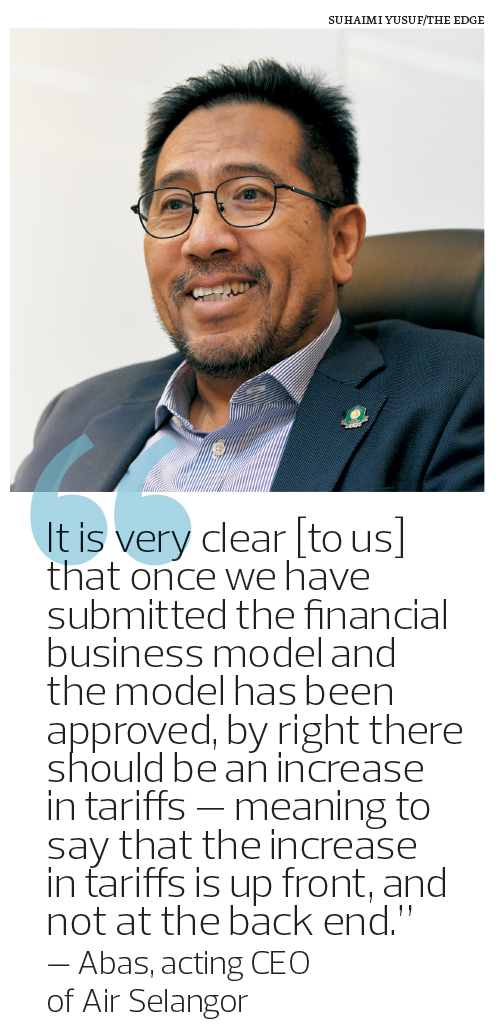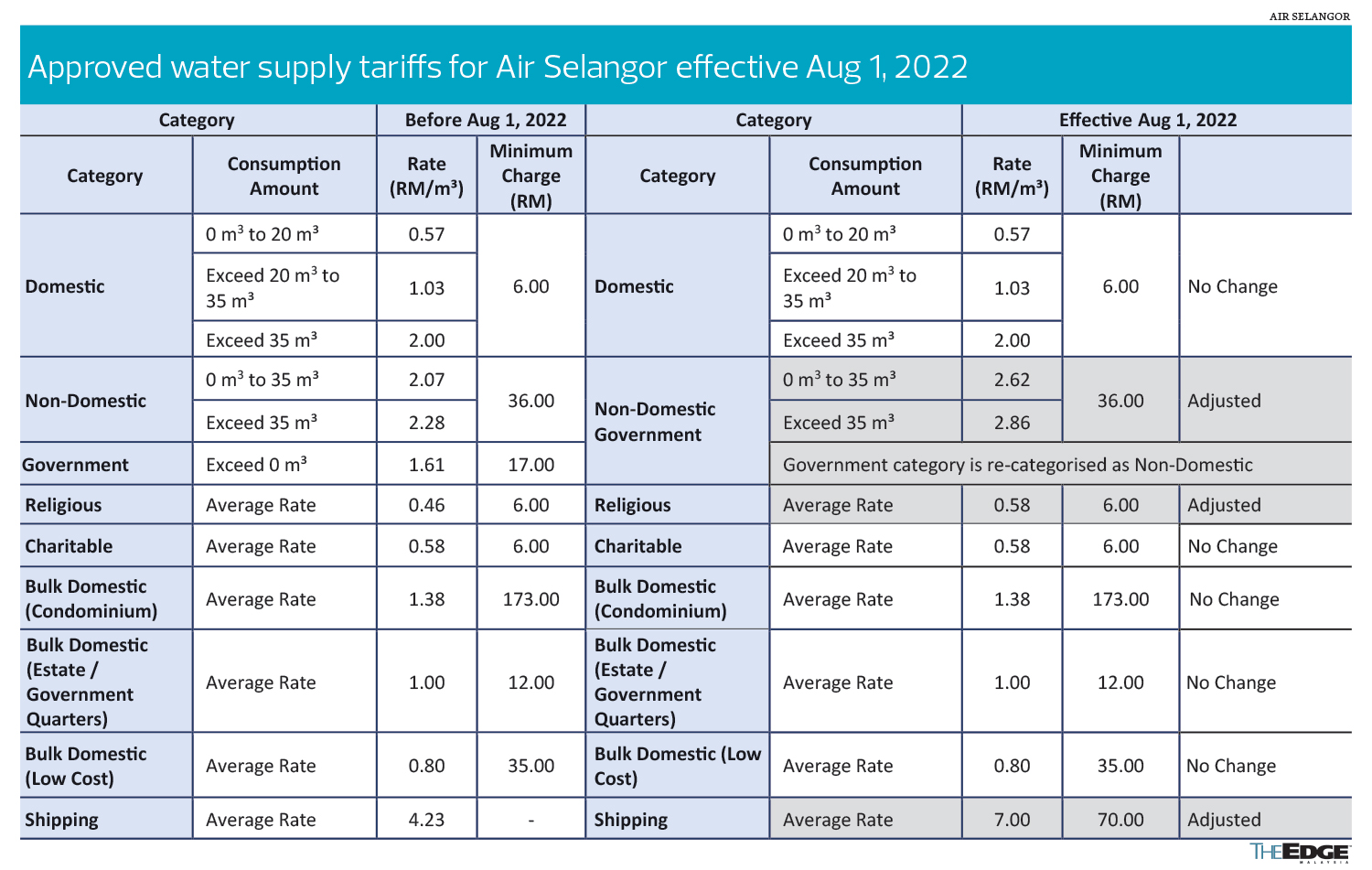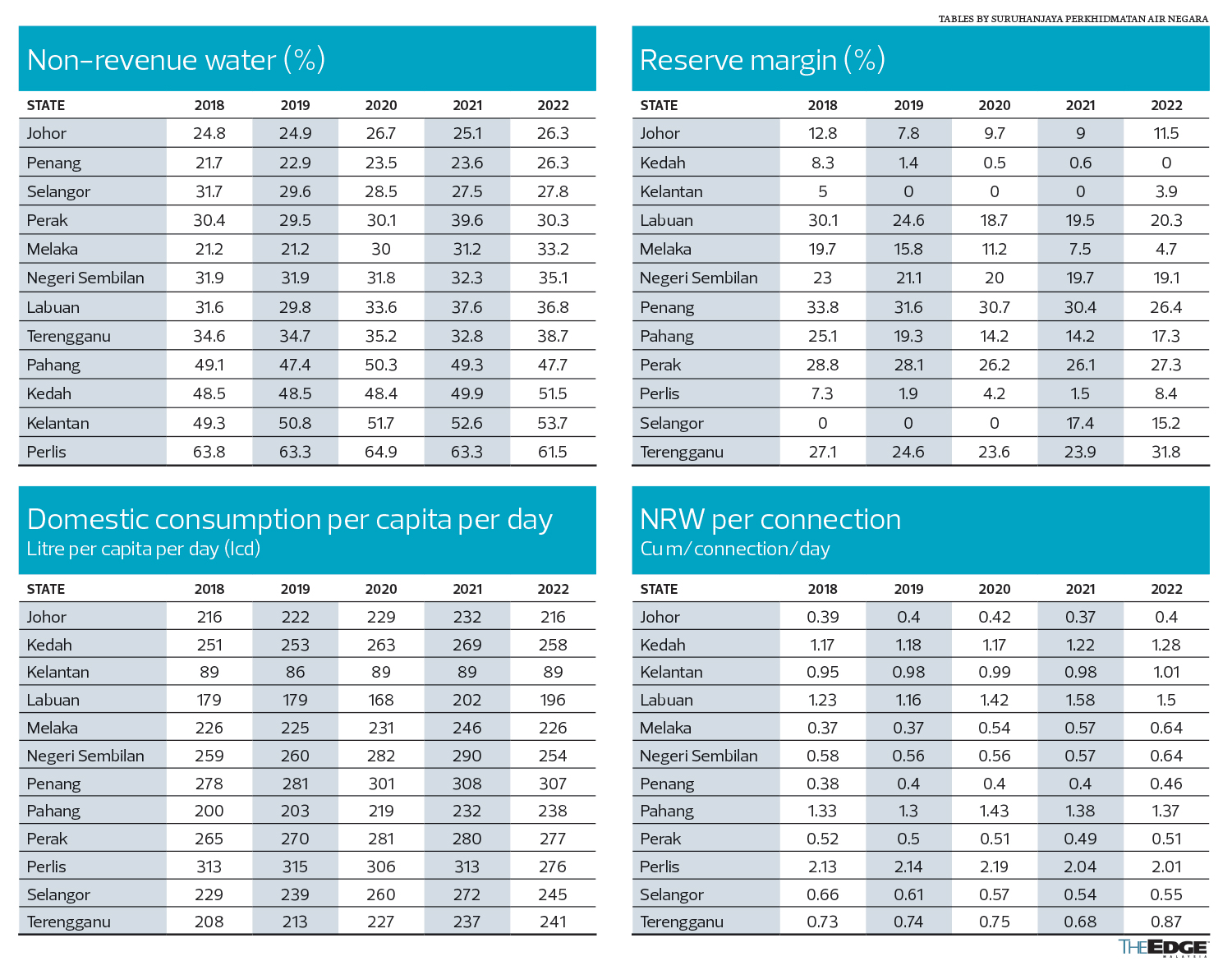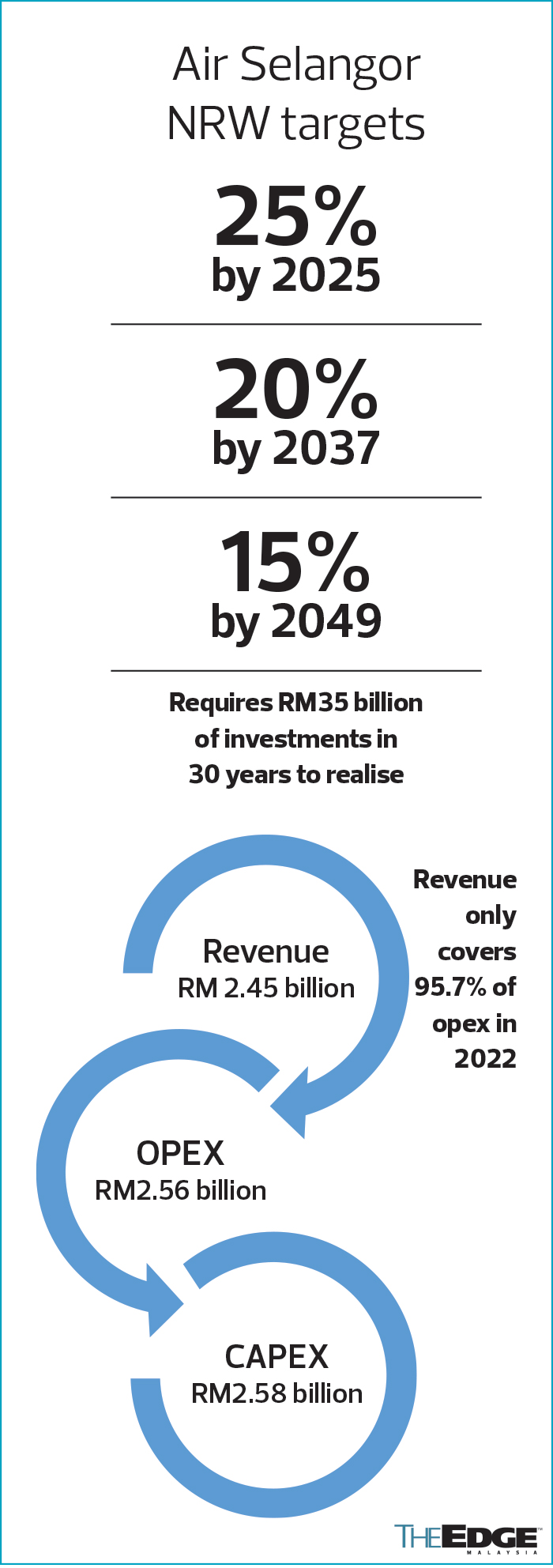
This article first appeared in The Edge Malaysia Weekly on July 3, 2023 - July 9, 2023
THAMES Water, the largest water utility company in the UK, is on the verge of collapse under a £14 billion (RM82.8 billion) debt burden. Its CEO Sarah Bentley is stepping down, just two years after taking the top job at the company that serves almost a quarter of the country’s population.
Now, the British media report that water services companies in the UK are proposing tariff increases of up to 40% in order to catch up with the investments needed to improve their performance. And lawmakers in Westminster are considering renationalising Thames Water.
While the situation in the UK, where water utility companies are privately owned, is different from Malaysia’s, where water service operators are owned by state governments, the issues plaguing them are the same — underinvestment in infrastructure that has resulted in low efficiency.
Here in Malaysia, the water services industry has been undergoing a restructuring for quite some time, since the Water Services Industry Act 2006 (WSIA) came into effect in 2008.
WSIA is the reference point for the restructuring of the country’s water sector, whereby water services were transferred from the State List to the Concurrent List of the Federal Constitution. The Concurrent List refers to matters that parliament and state legislative assemblies can make laws on. This means water supplies and services are a shared responsibility between the federal and state governments.
The funding model where all of the debts of the water services agencies and companies were taken over by Pengurusan Aset Air Bhd (PAAB) also emerged from WSIA. PAAB is wholly owned by Minister of Finance Inc and serves as the holding company for the nation’s water assets.
Under the new model, state water operators are no longer responsible for developing the infrastructure and its funding so they can concentrate solely on providing services to consumers and improving their operational efficiency. The task of developing water infrastructure and sourcing falls on PAAB.
With the transfer of assets, the state governments continue to be responsible for providing water supply in the states but instead of owning the assets, the state water operators lease those assets from PAAB for operation and maintenance. With the lease income, PAAB repays the federal loan (which it took over from the states) over a period of time.
But almost two decades since WSIA was passed, the spirit of the act, which seeks to provide a framework for a sustainable water services industry, is still a work in progress. The water services industry’s financing model is still far from sustainable, leading to low investments in water assets.
This situation, where tariff hikes on domestic users particularly were not approved or postponed, has resulted in water services companies deferring the upgrade of assets and maintenance works.
An underinvested system, which is already old to begin with and plagued with high leakages, will lead to even more leakages in the future. These leakages, or non-revenue water (NRW), will lead to water services companies requiring more revenue to plug the losses and maintain operations while the cost of labour and other inputs, like chemicals, rise.
This is the biggest problem faced by the country’s water services industry, and it is a burden that water services companies like Pengurusan Air Selangor Sdn Bhd has had to bear. For Air Selangor — the largest water operator in Malaysia — it is imperative that water tariffs, especially for domestic usage, be allowed to rise according to business needs and as per WSIA.
“As a water operator, we are governed by WSIA,” says Ir Abas Abdullah, acting CEO of Air Selangor, in an exclusive interview with The Edge at its headquarters in Bukit Pantai, Kuala Lumpur. “It is very clear [to us] that once we have submitted the financial business model and the model has been approved, by right there should be an increase in tariffs — meaning to say that the increase in tariffs is up front, and not at the back end.”
This means tariffs should be allowed to rise first, with the receipts from the increase used to implement Air Selangor’s capital and operational expenditures (capex and opex). The state-owned water company’s business model should not be invest first and pay later, as is the case now.
However, in the last operation period between 2019 and 2022, Air Selangor only managed to secure an increase in tariffs for non-domestic users, in August 2022. Non-domestic users are currently charged RM2.62 per cu m of water for the first 35 cu m of usage, compared with RM2.07 previously.
The tariff for domestic users, meanwhile, stays at 57 sen per cu m, despite Air Selangor claiming that it has proposed for a rise in tariff for domestic users based on the business and financial plan presented to the National Water Services Commission, or Suruhanjaya Perkhidmatan Air Negara (SPAN), which regulates water supply and sewerage services in Peninsular Malaysia and the federal territories of Kuala Lumpur, Putrajaya and Labuan.
“The water industry in Malaysia, especially in Selangor, needs to do a lot of catching up. At the same time, we also need to address future challenges. So, we need to accelerate all these [plans],” says Abas.
This means Air Selangor will need huge capital investments over the next few years to ensure the integrity of the water services system in the state. It supplies water to Selangor, Kuala Lumpur and Putrajaya.
Abas says that based on WSIA, once a water operator submits its proposal for a certain amount of funding for capex, it is reviewed by SPAN. With the key performance indicators set, the tariffs that comply with the required investments will be approved by the ministry that oversees the water industry. Currently, the industry is under purview of the Ministry of Natural Resources, Environment and Climate Change (NRECC), headed by Nik Nazmi Nik Ahmad, the member of parliament for Setiawangsa.
Just last week, he announced a lower electricity surcharge of 3.7 sen per kWh from 20 sen per kWh for state water and sanitation operators, which should help alleviate some of the pain felt by the players.
How much does Selangor’s water sector need?
Air Selangor has been up front on how much it needs to reduce NRW to 15% by 2049 — a whopping RM35 billion. Its NRW stood at 27.76% in 2022.
While the current system allows water services operators to propose water asset projects to PAAB, to be funded by the federal agency, Air Selangor also undertakes investments using its own funds.
But the current tariffs do not provide sufficient revenue for it to invest. The company had to turn to the debt market to raise funds.
In 2021, Air Selangor launched a RM10 billion Sustainability Sukuk to fund its programmes. As per its 2020-2021 Sustainability Sukuk Impact Report, the company issued three tranches of the sukuk, amounting to RM1.43 billion in total proceeds as at Sept 30, 2022. The sukuk issuances come with coupon rates 4.73% to 5.45%.
While raising debt to fund capital projects that will provide future income is a normal practice in the corporate world, Air Selangor has had to fund its opex with the proceeds from the sukuk as well.
Of the total RM1.43 billion raised, 20.5% was allocated to and utilised for the refinancing of capex, 28.2% for new capex and 16.9% for opex, according to Air Selangor. Some 34.4% of the proceeds have yet to be allocated or utilised and are invested in shariah-compliant money market instruments or fixed deposits, it says in the Impact Report.
In fact in 2022, Air Selangor spent RM2.58 billion in capex and RM2.56 billion in opex, according to the company’s Sustainability Report 2022, which was published last Friday. During the year, it registered revenue of RM2.45 billion, which was 12.44% higher than the RM2.18 billion in 2021.
It is clear that Air Selangor’s revenue is insufficient to cover its opex, let alone finance its capex.
According to SPAN CEO Datuk Ahmad Faizal Abdul Rahman, when it comes to setting water tariffs, the first band of the tariff for domestic usage should be sufficient to cover the opex of water services operators. In Air Selangor’s case, by right, the revenue from the charge on the first 20 cu m of usage for domestic users should be sufficient to cover its opex.
However, this is not the case, according to Air Selangor’s Sustainability Report. This is because it still charges domestic users 57 sen per cu m for the first 20 cu m of usage, when its cost of producing one cu m of water is “north of RM2.50”, according to Abas.
“We do not want non-domestic users to pay an unnecessarily high tariff, just because you want to subsidise domestic users. It is not fair because later, the tariff for non-domestic users will be very high, while domestic users enjoy a low tariff,” Faizal tells The Edge.
For SPAN, eventually all water services operators need to increase the first band of the tariff to at least cover their opex. In the case of Air Selangor, this could mean a charge of more than RM2.50 per cu m, which is more than four times the current rate.
Obviously, the cost to produce one cu m of water will continue to rise due to inflation and continued investments. That is why Air Selangor says it has a lot of “catching up” to do.
“Every user will at least pay for the opex, while those whose usage is in the higher bands and non-domestic users will cover capex as well,” says Faizal.
“In reality, if the infrastructure is being built properly, your capex will be much higher than your opex. If you are quite efficient, your opex will not be very high. It can be less than RM1 per cu m.”
Shouldn’t water services operators plug leakages first?
While Air Selangor and other water services operators have been asking for higher tariffs, some opine that they should reduce their NRW first before considering charges. The revenue from plugging NRW should be able to cover much of the operators’ expenses, they say.
Consider this: Air Selangor produced 5.12 million litres per day (MLD) of treated water in 2022, according to SPAN’s 2022 Water and Sewerage Factbook. During the year, it “lost” as much as 1.42 MLD of treated water. At 57 sen per cu m, the 1.42 MLD could yield about RM800,000 in revenue a day and RM295.4 million a year for the company.
However, that would only be possible in a blue sky scenario, where all the pipes are new and there are no burst pipes caused by multiple factors, whether human or natural. Air Selangor has a total of 30,422km of pipe length, and about 6,000km of them are old, asbestos cement pipes, says Abas.
“When we took over [the water operations from the concessionaires], we inherited these old assets, ageing pipes and so on. So definitely, we need to plough in the investment. If you want a good system or good service delivery, definitely we have to invest a lot,” he says.
The restructuring of the water services sector in Selangor was a long and hard endeavour.
While the restructuring started with the passing of the WSIA bill in 2006, the state government’s negotiations to take over the water concessions from the four concessionaires — Puncak Niaga (M) Sdn Bhd, Syarikat Bekalan Air Selangor Sdn Bhd (Syabas), Konsortium Abass Sdn Bhd and Syarikat Pengeluar Air Sungai Selangor Sdn Bhd (Splash) — were protracted.
Puncak Niaga, Syabas and Konsortium Abass were acquired in 2015, while the acquisition of Splash was only done in August 2018. Financial and political haggling between all the parties involved in the restructuring dragged negotiations on for years, during which time there were changes in government, menteri besar and federal ministers.
Air Selangor’s NRW has been declining over the years. In 2018, its NRW stood at 31.7%. In fact, the company is one of the few water services operators in the peninsula and Labuan that has had declining NRW, with the others being the operators in Perlis and Pahang.
Obviously, there is still a long way to go from 27.76% to 15% in 2049. And Abas wishes more could be done. However, even if Air Selangor were to expedite its investments and replace the pipes, it would need a drastic increase in tariffs, which Abas says he won’t push for.
In theory, the tariffs are supposed to rise every three years, says SPAN’s Faizal. However, these increases need to be approved by the cabinet and there are “other considerations” apart from merely capex and opex programmes, he adds.
“For example, last year, we submitted tariff increases for both domestic and non-domestic users, but only the increase in non-domestic users’ tariff was approved, because of the general election. So actually, the tariff now is behind the cycle,” says Faizal.
He admits that it is hard to push for tariff increases. However, he says the tariff hikes for both domestic and non-domestic users should go up together so that the opex is shared by both classes of users.
As the tariff for domestic usage was not increased in August 2022, the tariff could double for domestic users in the next cycle in order to catch up with the tariff hike cycles, says Faizal.
“This is what we don’t want. It would be better for the tariff to rise gradually, perhaps five sen per cu m every year, rather than a 50 sen jump in one go. But we can only propose [based on the business plans of the water services operators], and the minister will be the one to approve,” he says.
Save by subscribing to us for your print and/or digital copy.
P/S: The Edge is also available on Apple's App Store and Android's Google Play.





